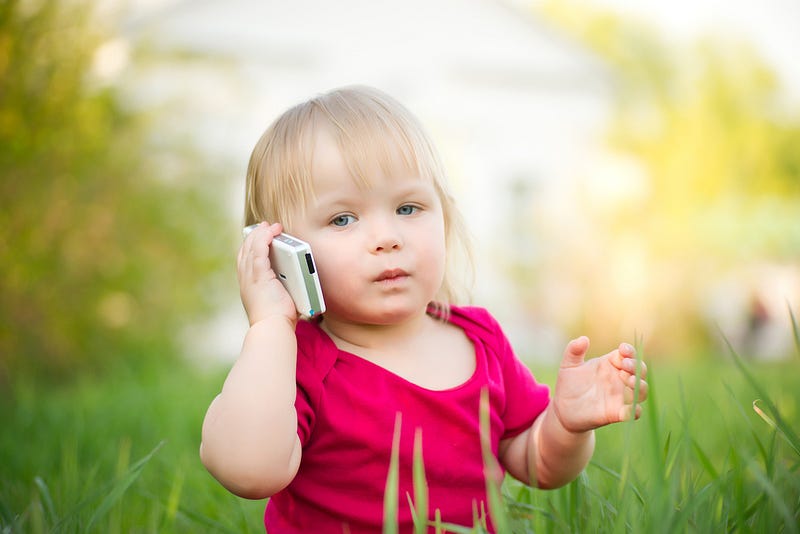Talking to Your Mother with That Mouth: The Development of Language in Infants
By Emma Tusuzian, Psychology, 2023

At four months old, we begin our linguistic journeys with receptive language, or the ability to comprehend speech. This means we can already distinguish phonemes, the most basic units of sound. Around the same time, we develop productive language, the ability to produce words and speech. At ten months, we start babbling, playing with different sounds until they become language-specific. “Mama.” The meaningful one-word stage comes in at around one year old, and by eighteen months, we are armed with two-word speech. “More food.”
Countless parenting books and online guides indulge new mothers with information about their baby’s growth, teaching them when to root for their child to say “mama.” The stages of language development are easy to observe and commonly known, but the “how” and “why” behind childhood language acquisition remain a mystery. From B. F. Skinner’s idea of nurture to Noam Chomsky’s idea of nature, renowned 20th century psychologists have attempted to explain development, learning, and thinking.
The stages of language development are easy to observe and commonly known, but the “how” and “why” behind childhood language acquisition remain a mystery.
Skinner’s Operant Learning Theory suggests we learn language by associating words with their meanings, imitating the language patterns observed in others, and revising our own use of language based on reinforcement from authority figures. Being “nurtured” by external and environmental influences allows us to develop language. Chomsky’s Theory of Inborn Universal Grammar, however, claims that children’s language use is too complex to be explained by operant learning. Children instead come pre-wired with a language acquisition device, a theoretical innate mental capacity allowing infants to acquire and produce language. This language skill is therefore a “natural” capacity hard-wired into the brain at birth.
In addition to theories of different language acquisition sources at infancy, there is a popular concept surrounding the significance of age in language development. Some psychologists believe that childhood is a limited window of time when we are especially apt to learn and master skills; it is a critical period for language development. After age seven, children who have never had exposure to language struggle to master it and do not develop the fluency of a native speaker. Speed of development is one of many other differences between language learning in children and adults, which may give insight into what makes this age vital for communication.
After age seven, children who have never had exposure to language struggle to master it and do not develop the fluency of a native speaker.
Though many hypotheses surrounding acquisition are difficult to prove, 21st century research has made leaps and bounds in understanding the importance of a child’s early relationship with language. A child’s learning environment is never without the slow, exaggerated speech of adults fawning over an endearing babbling baby. While “baby talk,” also known as Parentese or Motherese, often seems instinctual, it has been observed to support language development. In a study on the effectiveness of Parentese, a slow rate of speech and an emphasis on vowels led to large improvements in infants’ ability to recognize words. Infants were then better able to differentiate these clearer sounds when given enough time to process them.
Repetition of words also seems to support a strong mental representation, or a symbolic connection to words, and eventually a more accurate production, or articulation of those words. A University of Pennsylvania study investigated the ability of newborns to learn simple repetition-based structures through brain imaging. Scientists had newborns listen to basic syllable sequences with immediate repetition (e.g. “mubaba”) mixed with random control sequences (e.g. “mubage”). They found repetition sequences triggered greater brain activation than the random sequences. The brains of newborns responded the same way to repeated patterns of stimuli automatically, suggesting this was most likely a natural mechanism. As trials continued, activation only increased in response to the repetition sequences, showing that repeated exposure improved recognition of the pattern. Ultimately, the study suggests words that contain repeated sounds, which are typical of baby talk, have an advantage for early language learning.
he study suggests words that contain repeated sounds, which are typical of baby talk, have an advantage for early language learning.
While many studies point to the benefits of Parentese, some encourage parents to learn strategies for optimal language learning. Knowledge and feedback on language practices meant immediate and longer-term positive impacts on language skills, as babies showed improvements at 14 months compared to those of parents without coaching.
Recent research has suggested exaggerated speech offers the best input for language learning. Infants tested were capable of segmentation, identifying boundaries between words or syllables in spoken languages, only when they heard “baby talk.” This is just the start of understanding language development in its prime efficiency, which could lead into discussions of other forms of communication. Do these discoveries have further implications about mannerisms or instincts that unknowingly influence the development of our children?
DOI: 10.1073/pnas.0806530105
DOI: 10.1111/desc.12762
DOI: 10.1121/1.3419786
DOI: 10.1016/j.cognition.2015.12.004
